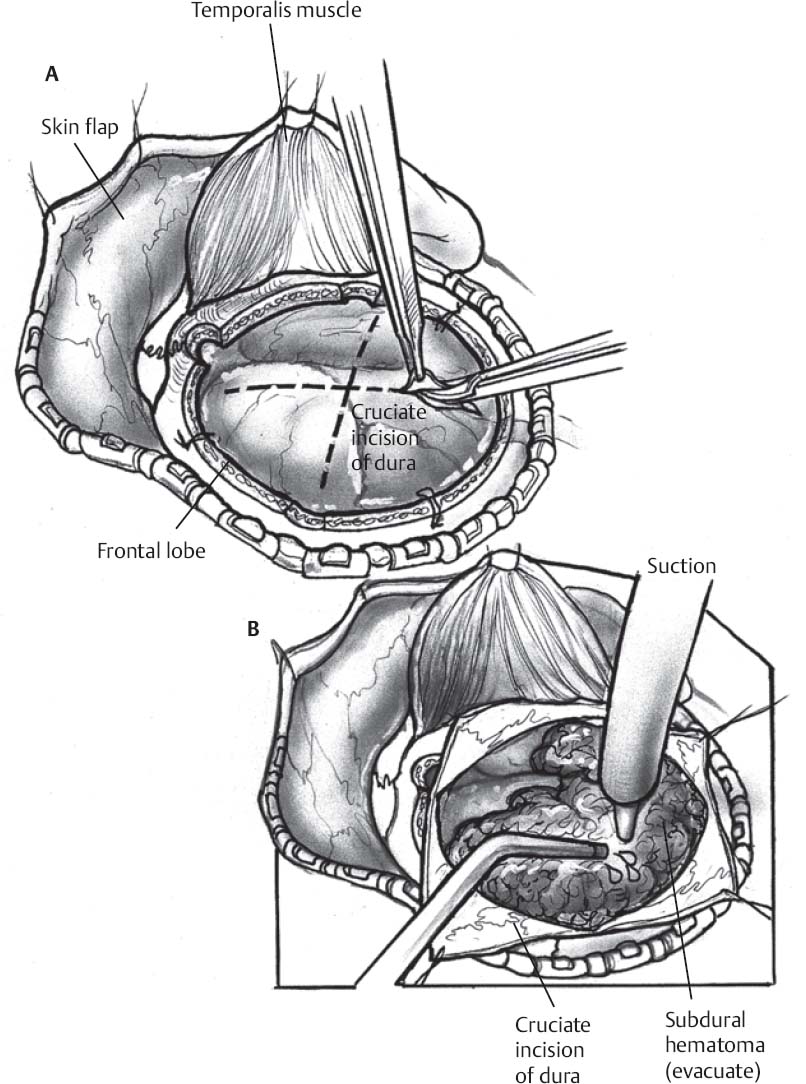♦ Preoperative
Operative Planning
- Review imaging studies
- Non-contrast head computed tomography (CT) essential for precise localization of subdural hematoma (SDH); most often located at the frontotemporo-parietal convexity from bleeding of injured parasagittal or cortical veins
- Adjust window on CT scan to detect chronic appearing SDH, which may have similar density to brain
- Non-contrast head computed tomography (CT) essential for precise localization of subdural hematoma (SDH); most often located at the frontotemporo-parietal convexity from bleeding of injured parasagittal or cortical veins
Equipment
- Mayfield head holder: clamp or horseshoe
- Basic craniotomy tray
- Burr hole tray
- High-speed drill with appropriate drill bits
- Bone flap fixation tray
- Hemostatic agents (Avitene, Gelfoam, Surgicel, bone wax)
- Intracranial pressure (ICP) monitor or external ventricular drain system if needed
Operating Room Set-up
- Headlight and loupes
- Bovie electrocautery
- Bipolar cautery
Anesthetic Issues
- Preoperative intravenous antibiotics administered within 30 min prior to incision (cefazolin 2 g intravenously or clindamycin 600 mg intravenously)
- Arterial line useful for blood pressure monitoring in acute SDH evacuation cases
- Load with phenytoin (15 to 18 mg/kg) administered slowly, or alternatively, levetiracetam 1000 to 1500 mg intravenously
- Communicate with anesthesiologist suspected degree of ICP elevation and if needed:
- Hyperventilation to pCO2 of 30 to 35 mm Hg
- Mannitol 0.5 to 1 g/kg infusion starting at time of skin incision
- Propofol (if indicated)
- Hyperventilation to pCO2 of 30 to 35 mm Hg
- Surgeon should warn anesthesiologist of potential hypotension at the time of clot evacuation as blood pressure is often supported by a sympathetic response to increased ICP
♦ Acute Subdural Hematoma
Intraoperative
Positioning
- In general, the patient should be semilateral with head neutral (since C-spine may not be cleared).
- Mayfield skull pin sites are kept out of the field and behind hairline and away from any skull fractures.
- Neck should be positioned to avoid compression of the jugular veins and kinking of the endotracheal tube.
- Ipsilateral shoulder elevation with a shoulder roll and head of bed elevation may be utilized to ensure good jugular venous outflow.
Planning of Incision
- Especially in emergency situations, ensure CT scan showing acute SDH is available in operating room where correct side can be verified.
- With electric clippers, a strip of hair of approximately ~3 cm in width is shaved over the planned incision or widely over the entire frontotemporoparietal area.
Incision and Scalp Flap
- Reverse question mark incision is begun 1 cm anterior to tragus, curved superiorly and posteriorly over the pinna, and extended to the midline and terminating at the hairline.
- Raney clips and bipolar cautery are used to control scalp bleeding.
- Temporalis muscle is divided in line with the incision and reflected anteriorly with the scalp flap.
Burr Holes
- Temporal burr hole placed first
- Additional burr holes placed as needed based on size/location of planned craniotomy
Craniotomy
- Use Penfield no. 3 to free the underlying dura from the bone.
- Craniotome is used to cut the craniotomy being sure to stay at least 1 to 2 cm lateral to midline to avoid the superior sagittal sinus.
- The bone flap is elevated with a periosteal dissector or Penfield no. 3.
- Either a cruciate opening or a U-shaped dural opening based anteriorly (Fig. 67.1), which is extended posteriorly as a T, can be utilized.
- Dural tenting sutures are placed circumferentially along the craniotomy edges.
Evacuation
- The hematoma is removed by using a combination of suction, forceps, and irrigation.
- Obtain hemostasis with bipolar cautery, Surgicel, Avitene, or Gelfoam.
- Inspect under the margins of the craniotomy to evacuate additional clot and to stop bleeding.
- Irrigate copiously to extract as much clot as possible.
Closure
- Close dura with 4–0 Nurolon sutures
- Place multiple central dural tack-up sutures and cover dura with Gelfoam or Duragen to minimize epidural space.
- Bone flap secured with titanium miniplates and screws
- If severe cerebral edema and refractory ICP elevation are anticipated, may consider insertion of ICP monitor or not replacing the bone flap
- Subgaleal drain is optional
- Temporalis muscle and fascial layers are closed with 0 or 3–0 Vicryl sutures
- Galea closed with inverted 3–0 Vicryl sutures
- Skin closed with staples
- Incision covered with Xeroform petroleum gauze dressing, 4 × 4 gauze, and a compressive head wrap
Postoperative
- Continue postoperative antibiotics for 24 hours
- Obtain postoperative head CT
- Patient is monitored in neurosurgery intensive care unit until stable
♦ Chronic Subdural Hematoma
Preoperative
Equipment
- Burr hole tray
- Horseshoe or Mayfield
Planning of Shave and Preparation
- Shave ~3 cm wide strip along planned incision
< div class='tao-gold-member'> Only gold members can continue reading. Log In or Register to continue
Only gold members can continue reading. Log In or Register to continue
Stay updated, free articles. Join our Telegram channel

Full access? Get Clinical Tree






